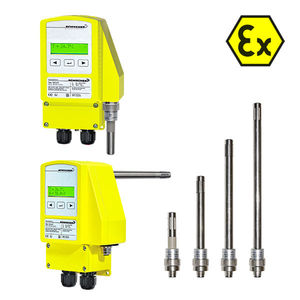
Relative pressure transmitter ExCos-Pdifferentialmembraneanalog




Add to favorites
Compare this product
Characteristics
- Pressure type
- relative, differential
- Technology
- membrane
- Output
- analog
- Mounting
- wall-mounted
- Material
- stainless steel
- Protection level
- explosion-proof, ATEX, IP66
- Applications
- for HVAC systems
- Other characteristics
- with display, programmable, low pressure
- Pressure range
Max.: 7,500 Pa
(1.09 psi)Min.: 100 Pa
(0.01 psi)- Process temperature
Max.: 50 °C
(122 °F)Min.: -20 °C
(-4 °F)
Description
Electrical, explosion proof transmitter with display series ExCos-P for differential pressure control in HVAC systems.
- Certified according to ATEX, IECEx and more
- use in hazardous locations
- for all kind of gas, mixtures, vapours and dust
- Interface in the safe area is not required
- installation of intrinsic safe circuit is not required
- saves cost, space and guarantees safety
- all parameters can be adjusted on site without additional tools
- 24 VAC/DC supply
- Measuring range ± 100 Pa, ± 250 Pa, ± 600 Pa, ± 1250 Pa, ± 2500 Pa, ± 5000 Pa, ± 7500 Pa
- Working range adjustable
- Output 0-10 VDC and (0)4-20 mA, slectable
- actual value indication
- Aluminium housing IP66
- Dimensions (H × W × D) 180 × 107 × 66 mm
- Weight approx. 1 kg, VA version approx. 2,3 kg
- integral Ex-e terminal box
- Stainless steel version or with offshore/marine coating optional
- Series ExCos-P for use in Zone 1, 2, 21 and 22
- Series RedCos-P for use in zone 2 and 22
- Series InCos-P for use in safe area (industrial applications)
Catalogs
Exhibitions
Meet this supplier at the following exhibition(s):

Other Rotork Schischek products
Analog Transmitters and Sensors, Electric, Explosion Proof
Related Searches
- Pressure transmitter
- Analog pressure transmitter
- Pressure switch
- Pressure probe
- Membrane pressure transmitter
- Relative pressure transmitter
- Stainless steel pressure transmitter
- Waterproof pressure transmitter
- Mechanical pressure switch
- Waterproof pressure switch
- Analog pressure probe
- Diaphragm pressure switch
- Relative pressure probe
- Adjustable pressure switch
- Pressure transducer
- Differential pressure transmitter
- Explosion-proof pressure transmitter
- Differential pressure switch
- Gas pressure switch
- Analog pressure transducer
*Prices are pre-tax. They exclude delivery charges and customs duties and do not include additional charges for installation or activation options. Prices are indicative only and may vary by country, with changes to the cost of raw materials and exchange rates.







